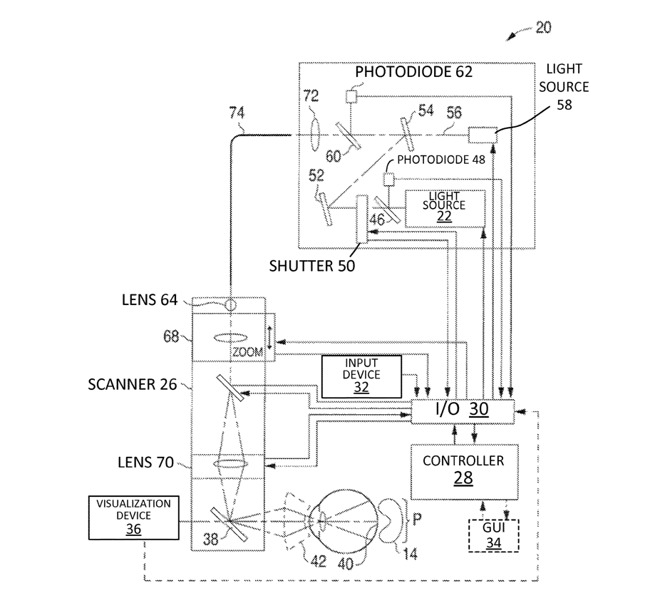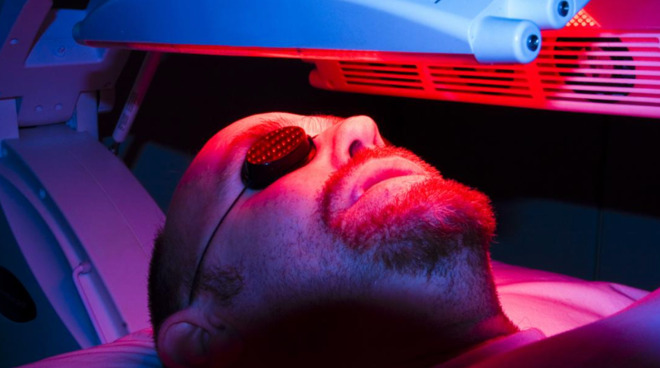Apple investigating expansion into major health hardware [u]
Important update: the photomedicine patent reported on here was mistakenly assigned to Apple. Inventor Dan Anderson has filed the US Patent office for a correction.
Thanks to Dan Anderson for contacting AppleInsider with copies of his correction paperwork. We are leaving the rest of the original story here as it has been widely circulated and so links back to this piece will now show the correction. For completeness, the newly corrected assignee is Topcon Medical Laser Systems Inc.
This isn't something you're going to see added to the Apple Pencil. It's not something Tim Cook is likely to announce at some future WWDC alongside an ARM Mac. But Apple's widespread, wide-scale work on health now includes research into areas more associated with hospital equipment than iPhones.
"Area scanning photomedicine device and method," US Patent No 10,617,564, is a detailed patent application which covers an extremely broad range of medical issues -- but chiefly does so with one purpose.
"[It is a] system and method for treating a lesion on target tissue," says the patent.
Currently, so-called superficial lesions -- "[meaning that] the lesion is on or near the surface of target tissue" -- can be treated using light. The patent lists countless applications including, for instance, photodynamic therapy (PDT) which, typically in combination with a light-sensitive drug, uses a light source to destroy cancer cells.
Light is also used in, for example, "gynecology, gastroenterology, and thoracic surgery," and Apple notes that this is far from an exhaustive list. However, Apple also notes that "although the details of the approaches vary due to the anatomical differences presented, the fundamental underpinnings are the same." And it's these underpinnings that Apple wants to address with this patent.
"[Currently] one must provide treatment light to the targeted lesion," says the patent. "To date, this has been done primarily with broad-brush application of light to the lesion and its surrounding tissue. While this has the advantage of being straightforward, it also limits the ultimate clinical efficacy by increasing the side effect profile."
In other words, the "therapies are not sufficiently site-selective," and this is a problem because the "irradiation of adjacent tissue causes more damage than is necessary." What Apple is ultimately proposing is a new system of much finer accuracy when aiming and using light treatments on lesions.
"The present invention solves the aforementioned problems by providing a multipurpose system for performing a variety of photomedical procedures that is based on contiguous scanning of a continuous wave (cw) or quasi-cw light source," claims the patent.

Typical block diagram from the patent, demonstrating the arrangement of devices instead of any specific hardware
Apple's plan is for a device that combines different systems. It starts with a "visualization device" for "capturing an image of target tissue containing a lesion." Then when that image is acquired, it has a targeting system that combines a light source, a scanner device that can aim that light, and an overall controller.
The Apple device first captures an image that can show precisely where the boundaries of the lesion extend. Then it projects "treatment pattern onto the target tissue."
Most of the patent application's drawings are either examples of lesion patterns, or block diagrams of the combination of light source and controllers. There's no sketch of a doctor wielding an iPhone. If Apple's patent results in new hardware, it's going to be hospital-grade machinery rather than something that'll be featured in a Today at Apple store demo.
The invention is credited to Dan Anderson and David Mordaunt, each of whom have more than sixty prior patents, the majority of which are in related fields such as Anderson's "System and method for determining dosimetry in ophthalmic photomedicine," or Mordaunt's "Photomedical treatment system and method with a virtual aiming device."
Updated: 15:35 ET with new information from inventor Dan Anderson
Thanks to Dan Anderson for contacting AppleInsider with copies of his correction paperwork. We are leaving the rest of the original story here as it has been widely circulated and so links back to this piece will now show the correction. For completeness, the newly corrected assignee is Topcon Medical Laser Systems Inc.
This isn't something you're going to see added to the Apple Pencil. It's not something Tim Cook is likely to announce at some future WWDC alongside an ARM Mac. But Apple's widespread, wide-scale work on health now includes research into areas more associated with hospital equipment than iPhones.
"Area scanning photomedicine device and method," US Patent No 10,617,564, is a detailed patent application which covers an extremely broad range of medical issues -- but chiefly does so with one purpose.
"[It is a] system and method for treating a lesion on target tissue," says the patent.
Currently, so-called superficial lesions -- "[meaning that] the lesion is on or near the surface of target tissue" -- can be treated using light. The patent lists countless applications including, for instance, photodynamic therapy (PDT) which, typically in combination with a light-sensitive drug, uses a light source to destroy cancer cells.
Light is also used in, for example, "gynecology, gastroenterology, and thoracic surgery," and Apple notes that this is far from an exhaustive list. However, Apple also notes that "although the details of the approaches vary due to the anatomical differences presented, the fundamental underpinnings are the same." And it's these underpinnings that Apple wants to address with this patent.
"[Currently] one must provide treatment light to the targeted lesion," says the patent. "To date, this has been done primarily with broad-brush application of light to the lesion and its surrounding tissue. While this has the advantage of being straightforward, it also limits the ultimate clinical efficacy by increasing the side effect profile."
In other words, the "therapies are not sufficiently site-selective," and this is a problem because the "irradiation of adjacent tissue causes more damage than is necessary." What Apple is ultimately proposing is a new system of much finer accuracy when aiming and using light treatments on lesions.
"The present invention solves the aforementioned problems by providing a multipurpose system for performing a variety of photomedical procedures that is based on contiguous scanning of a continuous wave (cw) or quasi-cw light source," claims the patent.

Typical block diagram from the patent, demonstrating the arrangement of devices instead of any specific hardware
Apple's plan is for a device that combines different systems. It starts with a "visualization device" for "capturing an image of target tissue containing a lesion." Then when that image is acquired, it has a targeting system that combines a light source, a scanner device that can aim that light, and an overall controller.
The Apple device first captures an image that can show precisely where the boundaries of the lesion extend. Then it projects "treatment pattern onto the target tissue."
Most of the patent application's drawings are either examples of lesion patterns, or block diagrams of the combination of light source and controllers. There's no sketch of a doctor wielding an iPhone. If Apple's patent results in new hardware, it's going to be hospital-grade machinery rather than something that'll be featured in a Today at Apple store demo.
The invention is credited to Dan Anderson and David Mordaunt, each of whom have more than sixty prior patents, the majority of which are in related fields such as Anderson's "System and method for determining dosimetry in ophthalmic photomedicine," or Mordaunt's "Photomedical treatment system and method with a virtual aiming device."
Updated: 15:35 ET with new information from inventor Dan Anderson


Comments
However, in the area of 'big iron' medical applications or nano applications with expensive hardware, support and training for medical staff, a level of commitment is required that I believe Apple doesn't have.
It could go down that route but IMO would need to create a totally new company, pump in money, hire the specialists and support it from afar. I don't see Apple as a good fit for that kind of operation.
Take cancer research, yearly R&D spends are on the order of only a few billions, and progress comes, but very slowly. This has impacted me personally as recently my mother was diagnosed with a GBM, which is a brain cancer that's thought to be largely incurable. Apple spent 16 billion on R&D in 2019 from what I can tell. For companies this large, even small ventures into novel R&D on healthcare could be comparable in magnitude to everything that's spent in a year on cancer research, or Alzheimer's research, or whatever else they turn their attention to.
That isn't in Apple's DNA whereas companies like Siemens and Fujitsu have proven track records. One of Fujitsu's promises is, "You can rely on us to take projects from bench to bedside”.
The only major project of a similar industrial nature at Apple is still under wraps (the car project) but we do suspect that, in spite of billions invested, the project itself has seen a lot of Apple's trademark changes. In direction, staffing, goals etc. Perhaps all unconfirmed but quite believable. For these kinds of projects (automible, health, ICT, aviation etc) there is so much prior research and know how involved that we are talking about large scale efforts. Pharmaceutical or thngs like devices for consumer use are different in nature but far more hit and miss in the sense that you can target one specific, limited goal and simply throw money at it.
As I said, Apple could do it but it would need to leave things alone and let the expertise do its thing and pump in financing. Much like it left Filemaker Inc to do its thing for years.